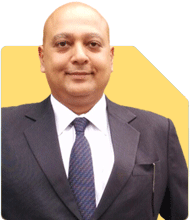Ramalingam Kalirajan |6161 Answers |Ask -Follow
Mutual Funds, Financial Planning Expert - Answered on Jul 18, 2024
He has an MBA in finance from the University of Madras and is a certified financial planner.
He is the director and chief financial planner at Holistic Investment, a Chennai-based firm that offers financial planning and wealth management advice.... more

I am 45 years age. Current investment balance in PF and VPF-45,00,000 mutual funds-27,00,000, Shares-700,000, NPS-6,00,000,LIC-10,00,000 Monthly investment PF and VPF-43,000, Mutual funds -32,000,NPS-6000, LIC-4500 Shares-10,0000. Yearly step up in PF vpf, mutual fund is 10% Current leaving in pune and home loan is 50,00,000. One home is in Nashik current market price is 75,00,000. I have daughter in 10th std and son in 6th std. Expecting Rs 50,00,000 on both education expenses after their 10th std. I want to retire at the age of 52. Expecting monthly income of Rs 1,00,000 after retirement.
Provident Fund (PF) and Voluntary Provident Fund (VPF): Rs. 45,00,000
Mutual Funds: Rs. 27,00,000
Shares: Rs. 7,00,000
National Pension System (NPS): Rs. 6,00,000
Life Insurance Corporation (LIC): Rs. 10,00,000
Your monthly investments are:
PF and VPF: Rs. 43,000
Mutual Funds: Rs. 32,000
NPS: Rs. 6,000
LIC: Rs. 4,500
Shares: Rs. 10,000
You own a home in Pune with a home loan of Rs. 50,00,000 and another home in Nashik with a market value of Rs. 75,00,000. Your daughter is in 10th std, and your son is in 6th std, with expected education expenses of Rs. 50,00,000 each.
You plan to retire at 52 and desire a monthly income of Rs. 1,00,000 post-retirement.
Financial Goals
Children's Education: Rs. 50,00,000 each after 10th std.
Retirement Planning: Achieve a monthly income of Rs. 1,00,000 post-retirement.
Loan Management: Efficiently manage the home loan of Rs. 50,00,000.
Recommendations for Financial Stability
1. Children's Education Fund
Dedicated Savings: Start a dedicated investment for your children's education.
Systematic Investments: Consider mutual funds tailored for education expenses with a horizon of 2-5 years.
2. Retirement Planning
Current Investments: Continue your current investments in PF, VPF, mutual funds, and NPS.
Retirement Corpus: Calculate the required retirement corpus to achieve Rs. 1,00,000 monthly income.
3. Home Loan Management
Prepayments: Make prepayments on your home loan whenever possible. This reduces interest and tenure.
Budget Allocation: Allocate a portion of any surplus towards prepaying the loan.
4. Portfolio Review and Diversification
Diversification: Ensure your portfolio is well-diversified across equity, debt, and other assets.
Regular Review: Review your portfolio annually and rebalance based on market conditions.
Analytical Insights
Children's Education Fund
Investment Strategy: Invest in a mix of equity and debt funds for a balanced approach.
Education Plans: Consider child education plans that offer a mix of growth and safety.
Retirement Planning
Corpus Calculation: To achieve Rs. 1,00,000 per month, you need a significant retirement corpus. Assuming a 4% withdrawal rate, you will need approximately Rs. 3 crores.
Current Contributions: Your current contributions are substantial. Continue with yearly step-ups to keep pace with inflation.
Risk Management
Insurance Coverage: Ensure adequate life and health insurance coverage.
Emergency Fund: Maintain an emergency fund of 6-12 months of living expenses.
Key Considerations
Risk Tolerance: Align your investments with your risk tolerance and financial goals.
Financial Goals: Prioritize your children's education and retirement planning.
Regular Review: Annual reviews and adjustments are crucial for staying on track.
Final Insights
To achieve financial stability and meet your goals, continue your disciplined investment approach. Start a dedicated fund for your children's education and make strategic prepayments on your home loan. Ensure your investment portfolio is diversified and regularly reviewed. Adequate insurance coverage and an emergency fund are essential for risk management. By following these recommendations, you can secure a comfortable retirement and provide for your children's education.
Best Regards,
K. Ramalingam, MBA, CFP,
Chief Financial Planner,
www.holisticinvestment.in
You may like to see similar questions and answers below
Samraat Jadhav |1989 Answers |Ask -Follow
Stock Market Expert - Answered on May 02, 2024
Ramalingam Kalirajan |6161 Answers |Ask -Follow
Mutual Funds, Financial Planning Expert - Answered on Apr 25, 2024
Ramalingam Kalirajan |6161 Answers |Ask -Follow
Mutual Funds, Financial Planning Expert - Answered on Jun 23, 2024
Ramalingam Kalirajan |6161 Answers |Ask -Follow
Mutual Funds, Financial Planning Expert - Answered on Jul 10, 2024
Nayagam P P |3589 Answers |Ask -Follow
Career Counsellor - Answered on Aug 30, 2024
Radheshyam Zanwar |696 Answers |Ask -Follow
MHT-CET, IIT-JEE, NEET-UG Expert - Answered on Aug 30, 2024
Nayagam P P |3589 Answers |Ask -Follow
Career Counsellor - Answered on Aug 30, 2024
Radheshyam Zanwar |696 Answers |Ask -Follow
MHT-CET, IIT-JEE, NEET-UG Expert - Answered on Aug 30, 2024
Radheshyam Zanwar |696 Answers |Ask -Follow
MHT-CET, IIT-JEE, NEET-UG Expert - Answered on Aug 30, 2024
Radheshyam Zanwar |696 Answers |Ask -Follow
MHT-CET, IIT-JEE, NEET-UG Expert - Answered on Aug 30, 2024
Sushil Sukhwani |522 Answers |Ask -Follow
Study Abroad Expert - Answered on Aug 30, 2024
Sushil Sukhwani |522 Answers |Ask -Follow
Study Abroad Expert - Answered on Aug 30, 2024
Ramalingam Kalirajan |6161 Answers |Ask -Follow
Mutual Funds, Financial Planning Expert - Answered on Aug 30, 2024
Ramalingam Kalirajan |6161 Answers |Ask -Follow
Mutual Funds, Financial Planning Expert - Answered on Aug 30, 2024























